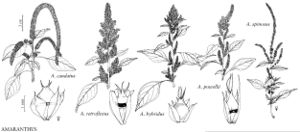Amaranthus spinosus
Sp. Pl. 2: 991. 1753.
Plants glabrous or sparsely pubescent in the distal younger parts of stems and branches. Stems erect or sometimes ascending proximally, much-branched and bushy, rarely nearly simple, 0.3–1(–2) m; each node with paired, divergent spines (modified bracts) to 1.5(–2.5) cm. Leaves: petiole ± equaling or longer than blade; blade rhombic-ovate, ovate, or ovate-lanceolate, 3–10(–15) × 1.5–6 cm, base broadly cuneate, margins entire, plane or slightly undulate, apex acute or subobtuse to indistinctly emarginate, mucronulate. Inflorescences simple or compound terminal staminate spikes and axillary subglobose mostly pistillate clusters, erect or with reflexed or nodding tips, usually green to silvery green. Bracts of pistillate flowers lanceolate to ovate-lanceolate, shorter than tepals, apex attenuate. Pistillate flowers: tepals 5, obovate-lanceolate or spatulate-lanceolate, equal or subequal, 1.2–2 mm, apex mucronate or short-aristate; styles erect or spreading; stigmas 3. Staminate flowers: often terminal or in proximal glomerules; tepals 5, equal or subequal, 1.7–2.5 mm; stamens 5. Utricles ovoid to subglobose, 1.5–2.5 mm, membranaceous proximally, wrinkled and spongy or inflated distally, irregularly dehiscent or indehiscent. Seeds black, lenticular or subglobose-lenticular, 0.7–1 mm diam., smooth, shiny.
Phenology: Flowering summer–fall.
Habitat: Waste places, fields, roadsides, railroads, barnyards, overgrazed pastures, other disturbed habitats
Elevation: 0-700 m
Distribution
Introduced; Man., Ont., Ala., Ark., Calif., Conn., Del., D.C., Fla., Ga., Ill., Ind., Iowa, Kans., Ky., La., Maine, Md., Mass., Minn., Miss., Mo., Nebr., N.J., N.Y., N.C., Ohio, Okla., Pa., R.I., S.C., Tenn., Tex., Vt., Va., W.Va., Wis., Mexico, West Indies, Central America, South America, introduced nearly worldwide.
Discussion
Amaranthus spinosus is native to lowlands in tropical America; at present it is a pantropical weed that also occurs in some warm-temperate regions.
Amaranthus spinosus, or its ancestral taxon, probably gave rise to the allopolyploid A. dubius by hybridization with some species of the A. hybridus aggregate (see above). Section Centrusa probably occupies a basal position, at least for the clade of subg. Amaranthus sect. Amaranthus, and probably for some representatives of subg. Acnida as currently outlined. Recent results of sequencing the ITS region (including ITS-1, 5.8S rDNA, and ITS-2) of nuclear ribosomal DNA from 15 species of Amaranthus occurring in China also suggest the basal position of A. spinosus among the studied species (Song B. H. et al. 2000). These results also confirm a profound divergence between subgenera Amaranthus and Albersia; the latter is called “sect. Paucestamen” by the above authors. Data on the electrophoretic variation of seed proteins (R. H. Sammour et al. 1993) are also in accord with the segregation of these two subgenera; in the cited article, these groups are called sect. Amaranthus and sect. Blitopsis.
Selected References
None.
